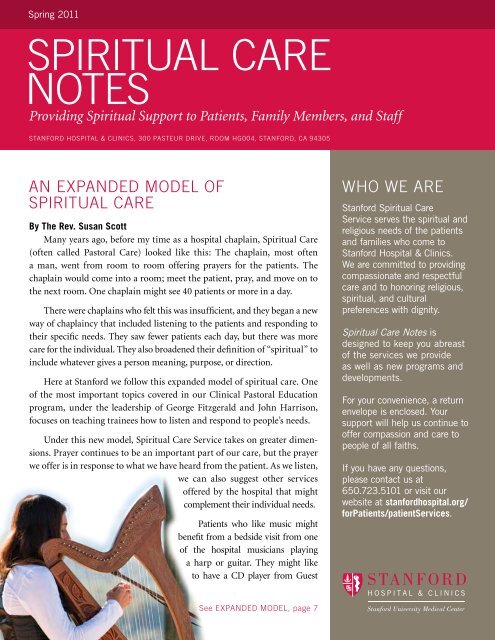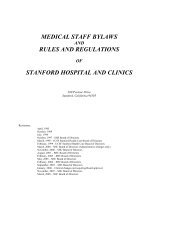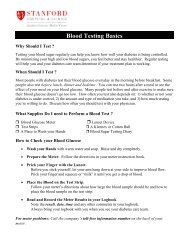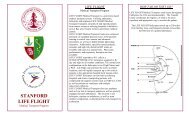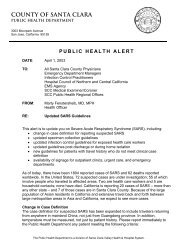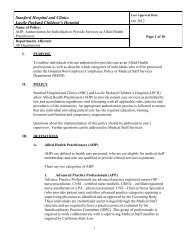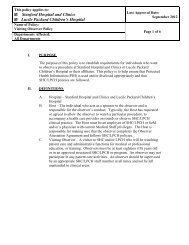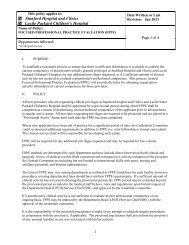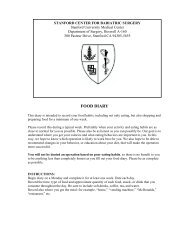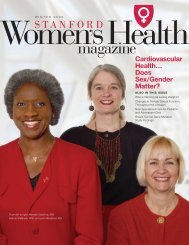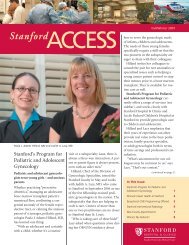SPIRITUAL CARE NOTES - Stanford Hospital & Clinics
SPIRITUAL CARE NOTES - Stanford Hospital & Clinics
SPIRITUAL CARE NOTES - Stanford Hospital & Clinics
Create successful ePaper yourself
Turn your PDF publications into a flip-book with our unique Google optimized e-Paper software.
Spring 2011<br />
<strong>SPIRITUAL</strong> <strong>CARE</strong><br />
<strong>NOTES</strong><br />
Providing Spiritual Support to Patients, Family Members, and Staff<br />
STANFORD HOSPITAL & CLINICS, 300 PASTEUR DRIVE, ROOm Hg004, STANFORD, CA 94305<br />
AN ExPANDED mODEL OF<br />
<strong>SPIRITUAL</strong> <strong>CARE</strong><br />
By The Rev. Susan Scott<br />
Many years ago, before my time as a hospital chaplain, Spiritual Care<br />
(often called Pastoral Care) looked like this: The chaplain, most often<br />
a man, went from room to room offering prayers for the patients. The<br />
chaplain would come into a room; meet the patient, pray, and move on to<br />
the next room. One chaplain might see 40 patients or more in a day.<br />
There were chaplains who felt this was insufficient, and they began a new<br />
way of chaplaincy that included listening to the patients and responding to<br />
their specific needs. They saw fewer patients each day, but there was more<br />
care for the individual. They also broadened their definition of “spiritual” to<br />
include whatever gives a person meaning, purpose, or direction.<br />
Here at <strong>Stanford</strong> we follow this expanded model of spiritual care. One<br />
of the most important topics covered in our Clinical Pastoral Education<br />
program, under the leadership of George Fitzgerald and John Harrison,<br />
focuses on teaching trainees how to listen and respond to people’s needs.<br />
Under this new model, Spiritual Care Service takes on greater dimensions.<br />
Prayer continues to be an important part of our care, but the prayer<br />
we offer is in response to what we have heard from the patient. As we listen,<br />
we can also suggest other services<br />
offered by the hospital that might<br />
complement their individual needs.<br />
Patients who like music might<br />
benefit from a bedside visit from one<br />
of the hospital musicians playing<br />
a harp or guitar. They might like<br />
to have a CD player from Guest<br />
See ExPANDED mODEL, page 7<br />
WHO WE ARE<br />
<strong>Stanford</strong> Spiritual Care<br />
Service serves the spiritual and<br />
religious needs of the patients<br />
and families who come to<br />
<strong>Stanford</strong> <strong>Hospital</strong> & <strong>Clinics</strong>.<br />
We are committed to providing<br />
compassionate and respectful<br />
care and to honoring religious,<br />
spiritual, and cultural<br />
preferences with dignity.<br />
Spiritual Care Notes is<br />
designed to keep you abreast<br />
of the services we provide<br />
as well as new programs and<br />
developments.<br />
For your convenience, a return<br />
envelope is enclosed. Your<br />
support will help us continue to<br />
offer compassion and care to<br />
people of all faiths.<br />
If you have any questions,<br />
please contact us at<br />
650.723.5101 or visit our<br />
website at stanfordhospital.org/<br />
forPatients/patientServices.
FROm THE DIRECTOR<br />
DISCOVERINg HOPE, SUSTAININg FAITH<br />
By the Rev. Dr. C. George Fitzgerald, S.T.D.<br />
Hope is usually thought of as one of the three<br />
primary virtues, the other two being faith and love.<br />
They often seem to occur in a chronological order. As<br />
we make our way in life, we usually start off by pledging<br />
our faith in a reality beyond ourselves, one that makes<br />
sense of who we are and how we live. As we proceed<br />
through the vicissitudes of life, we invariably experience<br />
the multifaceted forms of love—friendship, romance,<br />
compassion, affection, etc.<br />
Hope, however, tends to be more<br />
elusive as it has a way of both inviting<br />
and forcing us into the future. I suspect<br />
President Barak Obama sensed this<br />
orientation of hope toward the future<br />
when he wrote “The Audacity of Hope”<br />
and encouraged his followers when they<br />
chanted, “Yes, we can.”<br />
Getting a handle on hope is not easy.<br />
While we may recognize its fundamental<br />
nature, we also cannot help but find it a<br />
challenge to grasp. Yet it is the one thing<br />
that keeps us going when all else fails.<br />
In this regard, the well-known psychiatrist Karl A.<br />
Menninger makes a helpful and important distinction<br />
between hoping and hoping for. Hoping reflects a<br />
conviction that, regardless of how bad a situation looks,<br />
somehow something good will emerge out of it. Hoping<br />
for, on the other hand, represents an effort on our part<br />
to determine just what the hope is and how it should be<br />
revealed. When I was in high school I fervently hoped<br />
for a new car, convinced it would solve all my problems.<br />
Rather than being open and receiving, this kind of hope<br />
reflects our attempt to shape and determine the future.<br />
Assisting patients and family members in the<br />
hospital to discover hope is an essential component<br />
of spiritual care, and it seems to encompass all faith<br />
traditions. What cancer patient, for example, would not<br />
hope for a cure for his or her cancer?<br />
While suffering<br />
is woven into<br />
the fabric of life,<br />
there are also<br />
other meaningful<br />
threads that<br />
will endure and<br />
determine the<br />
ultimate pattern.<br />
PAGE 2<br />
But for some—and<br />
fortunately the number is<br />
decreasing—a complete cure<br />
does not occur. As chaplains,<br />
this is the kind of situation<br />
in which we attempt to assist<br />
patients to discern and discover<br />
a sustaining sense of hope.<br />
Perhaps it will come from a<br />
realization that<br />
in spite of their limitations they can reach<br />
out to others in caring and restorative ways.<br />
Or they may find that allowing others to<br />
care for them may give special meaning and<br />
fulfillment to that person.<br />
The emergence of hope is almost<br />
palpable when a seriously ill patient has<br />
a visit from a new grandchild or when a<br />
patient experiences reconciliation with<br />
a long-estranged sibling. Or it may be<br />
the sense of fulfillment that comes when<br />
a long-term project can be completed.<br />
Somehow, as hope emerges, it includes<br />
the recognition that while suffering is woven into the<br />
fabric of life, there are also other meaningful threads<br />
that will endure and determine the ultimate pattern.<br />
This past holiday season I received a card that struck<br />
me as rather strange when I opened the envelope. It<br />
came from an old friend who currently is a seminary<br />
president, and the cover consisted of a flickering<br />
candle surrounded by darkness. What a simple yet<br />
profound symbol of hope: The candle flickers, at times<br />
precariously, but it is not overcome by the darkness.<br />
This is the fundamental goal of our spiritual care:<br />
to assist patients in discovering and experiencing the<br />
gift of hope that will sustain and support them—to<br />
keep a candle flickering in the darkness. v<br />
The Rev. Dr. C. George Fitzgerald, S.T.D., is the Director<br />
of Spiritual Care Service. You can reach him at cfitzgerald@<br />
stanfordmed.org.
WITNESS TO A TRANSFORmATIVE ExPERIENCE<br />
By Peter Sayon, RN<br />
Recently I participated in the Catholic sacrament<br />
of Last Rites. It was the most memorable moment<br />
of my career life thus far—and I have been a nurse<br />
for more than 14 years.<br />
My patient was a family man in his mid-40s. He<br />
had a heart defect since birth and received a<br />
heart and double-lung transplant a few years ago.<br />
His body could not take it anymore and was<br />
gradually rejecting the lungs. Ventilator treatment<br />
was needed to sustain his life.<br />
That morning, I was told by the night<br />
nurse that we were waiting for the wife to<br />
finally decide to let him go. I know that it<br />
is not easy to decide such a thing, and<br />
there are times that you think only of<br />
preserving life. But knowing about the<br />
patient’s vital signs and laboratory results<br />
can tell you when a person is approaching<br />
the end of his or her life.<br />
When my patient’s family arrived that<br />
morning, I introduced myself and<br />
updated them about his status. The<br />
medical ICU team arranged a<br />
conference with the family, and an<br />
hour later I was informed by the doctor about the<br />
DNR-Do Not Resuscitate status of the patient as<br />
well as the plan to extubate—to remove the tube<br />
to the ventilator. The family was by the bedside,<br />
and the patient’s brother told<br />
me of their request for a<br />
Catholic sacrament of<br />
Last Rites.<br />
The Rev. John Hester<br />
joined the three family<br />
members around the<br />
patient’s bed: the<br />
brother, the sister and<br />
I became so<br />
immersed in the<br />
ceremony that I<br />
felt as though I<br />
was almost one<br />
with the family.<br />
PAGE 3<br />
the wife. A Spanish interpreter was present<br />
as well.<br />
The ceremony began. I joined the prayers, and I<br />
became so immersed in the ceremony that I felt as<br />
though I was almost one with the family. I was not<br />
an outsider anymore.<br />
After each family member blessed the patient with<br />
the holy oil, Father Hester asked me to do the<br />
same. He administered the sacrament, which<br />
made the patient and his family calm and<br />
peaceful. His words were carefully<br />
chosen, and they ran to my core like<br />
a tranquilizer, a remedy for a family<br />
in agony from losing a loved one.<br />
After the rites, I sensed that our<br />
patient and his family were ready.<br />
This event reminded me of my father,<br />
who died of lung cancer 14 years ago.<br />
I had just passed my nursing board<br />
exam and was volunteering in one of<br />
the provincial hospitals in the<br />
Philippines. Being a neophyte and<br />
naïve at that time, I shouted, “Do<br />
something!” to the doctors and nurses<br />
when he breathed his last. They<br />
attempted to intubate him at that very moment but<br />
to no avail. The look of struggle on my Dad’s face<br />
before he died still haunts me to this day.<br />
Back with our patient, we eventually extubated him<br />
and started a medication drip for pain. Two-and-ahalf<br />
hours later, he expired peacefully, with dignity<br />
and without pain, in the arms of his loved ones.<br />
Thanks to the wonderful celebration of the<br />
Anointing of the Sick by Father Hester, the patient<br />
and his family were able to accept the situation<br />
with less pain in their hearts.<br />
I wish that I had done the same with my father.<br />
Sometimes we are selfish and want to prolong the<br />
life of our loved ones because we will miss them.<br />
But we have to let go and let them depart this life<br />
peacefully. v<br />
Peter Sayon, RN, works in the North Intensive Care Unit of<br />
<strong>Stanford</strong> <strong>Hospital</strong>. He can be reached at psayon@stanfordmed.org.
FINDINg mEANINg IN mEDICINE<br />
Spirituality and Meaning in Medicine is taught by Chaplain<br />
Bruce Feldstein, MD, Marita Grudzen, and Arthur Johnson.<br />
This article is the first of a series on the program.<br />
By Chaplain Bruce Feldstein, MD<br />
Every four weeks in the School of Medicine, six<br />
to 10 medical students take a class called Spirituality<br />
and Meaning in Medicine (SMIM) during the required<br />
Family Medicine Core Clerkship.<br />
These medical students are a remarkable group<br />
of young people. Some are clear about their path in<br />
medicine; others are “in search” and still exploring.<br />
They describe themselves as atheist, agnostic, spiritual,<br />
or religious. They come from a wide range of cultural<br />
and religious backgrounds.<br />
What they do have in common is their dedication<br />
to medicine, to service, and—on our afternoon—to<br />
finding out more about spirituality and meaning in<br />
medicine, both personally and professionally.<br />
During the clerkship, students are required to spend<br />
an afternoon at a community site of their choice, where<br />
they can be exposed to different aspects of medicine<br />
and health care. Spiritual Care Service has become a<br />
popular choice that allows students to follow up on<br />
what they’ve been exposed to during SMIM. They<br />
tour the chapel, go on rounds with hospital chaplains<br />
to witness spiritual care at the bedside, and engage in<br />
group discussions to reflect on the deeper meaning of<br />
their experience.<br />
On our allotted afternoon, we gather at the garden<br />
entrance of <strong>Stanford</strong> <strong>Hospital</strong>, where the students arrive<br />
after a morning in their assigned clinics or at hospice.<br />
We head over to tour the chapel. Most have never been<br />
inside the chapel and many didn’t even know it was<br />
there, despite having been in the hospital many times.<br />
As we enter the chapel, the students are struck by<br />
“the quiet and the difference in lighting from the rest<br />
of the hospital” and “how calming it feels.” We may<br />
take a moment to sit, or perhaps stand, and simply be,<br />
PAGE 4<br />
focusing on our breath and experiencing the calm of<br />
the room. They remark on how welcoming the chapel<br />
is for people of different faiths. They are fascinated to<br />
see people of different traditions praying at the same<br />
time: for example, a Muslim man kneeling on a prayer<br />
rug while a Catholic prays the rosary and someone else<br />
sits in meditation.<br />
They are intrigued with the symbols from the different<br />
religious traditions on the wall, curious and a bit humbled<br />
to see how many (or how few) they can recognize. I point<br />
out the “answer key” on another wall, with descriptions<br />
of each of the symbols and its tradition.<br />
I pass out holy books in different languages for<br />
students to see if they can make out what book and<br />
language it is in—for example the Christian Bible in<br />
Chinese or Russian, the Torah in Hebrew, the Koran in<br />
Arabic, or Buddhist writings in Vietnamese.<br />
With reverence we look at the notebook in which<br />
people write their own prayers. We ponder them,<br />
sometimes adding one of our own. We leave the chapel,<br />
changed, and emerge back into the hallway to make<br />
our way back to the garden entrance. v<br />
Chaplain Bruce Feldstein, MD, is Director of the Jewish<br />
Chaplaincy. He can be reached at bfeldstein@stanfordmed.org.
STANFORD HOSPITAL RELIgION CENSUS 2010<br />
Spiritual Care Service is dedicated to providing comfort<br />
for people of all faiths, beliefs, and doctrines. The<br />
list on this page represents <strong>Stanford</strong> <strong>Hospital</strong>’s 2010<br />
total patient population divided into detailed religious<br />
categories. This information is used to estimate and allocate<br />
our future volunteers to the patient care units.<br />
CENSUS By RELIGION<br />
Number of Percentage<br />
Religion Patients of Total<br />
No Religious Preference 11,235 39.93%<br />
Christian* other than Catholic 6,961 24.70%<br />
Catholic 5,995 21.30%<br />
Requests no chaplain visit 984 3.50%<br />
Jewish 738 2.62%<br />
Buddhist 485 1.72%<br />
Patient declines to say 365 1.30%<br />
Muslim 317 1.13%<br />
Hindu/Jain 277 0.98%<br />
Unknown 276 0.98%<br />
Other Religion 238 0.85%<br />
Latter-day Saints (Mormon) 185 0.69%<br />
Sikh 41 0.15%<br />
Native American 12 0.04%<br />
Unity 12 0.04%<br />
Baha’i 9 0.03%<br />
Wicca 8 0.03%<br />
Religious Science 2 0.01%<br />
Totals 28,140 100.00%<br />
PAGE 5<br />
Our gratitude goes to Charles Dibble, PhD, and his<br />
assistant Aurora Yusi from <strong>Stanford</strong> <strong>Hospital</strong> Information<br />
System Support–Registration, for compiling these<br />
annual statistics.<br />
— The Rev. John Hester<br />
VOLUNTEER STATISTICS<br />
Spiritual Care Service expresses our deepest gratitude<br />
to the 184 dedicated volunteers who make this ministry<br />
possible. We would like to recognize the top 10<br />
volunteers of 2010 for their deep commitment:<br />
Volunteer Hours<br />
Penny Barrett 475<br />
Tony Iraci 337<br />
Judith Scanlon 261<br />
Tom Brosnan 231<br />
Patricia Connor 227<br />
Susan Thomas 210<br />
Louise McQuillen 201<br />
Donna Kruep 174<br />
Maureen Martin 171<br />
Rena Gretz 165<br />
VOLUNTEER TRAINING<br />
Volunteers trained this spring will graduate on<br />
Monday, May 16, at Our Lady of the Rosary Hall,<br />
3233 Cowper St., in Palo Alto. The class comprises<br />
Christian, Interfaith, Catholic, Buddhist (Chinese,<br />
Japanese, and Vietnamese), Muslim, Jewish, Hindu,<br />
and Latter-day Saints candidates.<br />
*Christian includes Apostolic, Armenian, Assembly of God, Baptist, Church of Christ, Church of God, Episcopal, Greek Orthodox, Jehovah’s<br />
Witnesses, Lutheran, Mennonite, Methodist, Nazarene, Pentecostal, Presbyterian, Protestant, Quaker, Russian Orthodox, Seventh-day Adventist,<br />
Unitarian, United Church of Christ
YOUR SUPPORT<br />
mATTERS<br />
The individuals, congregations, and<br />
foundations who contribute to Spiritual<br />
Care Service make a tremendous<br />
difference in many people’s lives. Your<br />
gifts help support Clinical Pastoral<br />
Education (CPE) for chaplain residents,<br />
enhance our services, and provide<br />
assistance to indigent patients and family<br />
members. Thanks to you, last year<br />
Spiritual Care Service made close to<br />
245,000 patient visits and provided more<br />
than 103,000 volunteer hours by 184<br />
active volunteers.<br />
Your philanthropy is important to<br />
patients and their families who are<br />
looking for solace during a stressful<br />
time. Please help sustain our presence<br />
in the hospital for people in need.<br />
In lieu of our annual solicitation letter, a<br />
self-addressed envelope is included in<br />
each newsletter for your contribution.<br />
Please indicate if you wish to support the<br />
Training Program for Chaplain Residents<br />
or the Patient Assistance Fund.<br />
LEADERSHIP<br />
Development Committee<br />
George Fitzgerald<br />
Marge Hildahl<br />
Anadel Law<br />
CPE Professional Advisory Group<br />
Will Masuda (Chair) Scott McLennan<br />
George Fitzgerald Judy Passaglia<br />
Carolyn Glauz-Todrank Barbara Ralston<br />
Marita Grudzen Jan Roberts<br />
John Harrison Susan Scott<br />
John Hester Liza Taft<br />
Lori Klein Robinetta Wheeler<br />
Volunteer Coordinating Committee<br />
Tom Brosnan (Chair) John Hester<br />
Penny Barrett Sherifa Ibrahim<br />
Mahesh Bhavana Lori Klein<br />
Bruce Feldstein Susan Scott<br />
George Fitzgerald Kathryn Stucki<br />
Don Gee Taqwa Surapati<br />
VOLUNTEER SPOTLIgHT<br />
Name: Tom Brosnan<br />
Religious Denomination: Roman Catholic<br />
How long have you been a Spiritual Care<br />
Service volunteer? 10 years<br />
Why did you choose to volunteer with<br />
Spiritual Care Service? When I retired, I knew<br />
that I wanted to give back to the community. I<br />
came from a family in the medical profession,<br />
and I thought that working in a hospital would<br />
be a good choice. I also knew of the good work<br />
the Rev. Hester did at the hospital, so I gave<br />
him a call to see if there was anything I could do to help. I started visiting<br />
patients soon afterwards.<br />
Best part of volunteering: Visiting patients. I love to hear about their<br />
problems, families, and praying with them. I really feel great on my drive<br />
home, reflecting on the people I have visited.<br />
I also enjoy working on the VCC committee. Several years ago the number<br />
of volunteers grew from 100 to 200. I applied my electronic background<br />
and recommended introducing procedures for the annual training classes.<br />
A year later we had the procedures in place, which means that the training<br />
remains consistent year to year.<br />
Biggest challenge: My biggest challenge was to learn how to listen and not<br />
talk about myself when visiting patients. It is human nature, when having a<br />
conversation, to either interrupt or to wait for their story to finish and tell<br />
when a similar event happened to me. I had to learn that I was there for the<br />
patients and to listen to them.<br />
A favorite story: One Sunday morning, a patient I visited was crying. I<br />
introduced myself and asked him if he wanted to pray and have communion.<br />
He told me that he just received some bad news from his doctor. His family<br />
lived in the Valley and was driving out to be with him. I stayed with him for<br />
three hours, until he told me he was feeling better and that his family would<br />
be there shortly. The next two Sundays I visited and prayed with him. The<br />
following Sunday, his room was filled with 10 of his family members. He<br />
saw me and invited me to join them. The room went quiet. He got out of<br />
bed and walked over to me, gave me a big hug, and whispered that he just<br />
received good news from his doctor. He introduced me to his family and<br />
told them that I was the one who was with him after receiving the bad<br />
news. They all thanked me. v<br />
Tom Brosnan received the 2008 Volunteer of the Year award for his dedication to Spiritual<br />
Care Service.<br />
PAGE 6
ExPANDED mODEL, continued from page 1<br />
Services so they can listen to a specific type of music. The<br />
chaplain might show a visitor how to find the music they<br />
enjoy on the hospital television system. With the help of<br />
the iTunes website, we were able to download a specific<br />
piece of music that a dying patient wanted to hear.<br />
There are other ways we have expanded our care<br />
for patients’ spirits. A patient may benefit from the<br />
opportunity to create artwork as therapy (Art for Health)<br />
or take pleasure in a visit from a specially trained dog (Pet<br />
Assisted Wellness at <strong>Stanford</strong>).<br />
Another patient asked to keep her Seeing Eye dog<br />
with her. Staff used their breaks to take her dog outside<br />
twice a day. With the dog close by, the patient felt more<br />
comfortable, got better, and went home. One family<br />
wanted some poems to read to their loved one who<br />
was hospitalized here. We searched on the Internet<br />
for their requested poetry. Rabbi Lori Klein visited a<br />
patient who had a dream of writing science fiction—<br />
<strong>SPIRITUAL</strong> <strong>CARE</strong> WEEk<br />
PAGE 7<br />
she helped him find information on how to publish his<br />
work and fulfill his ambitions.<br />
The Rev. John Hester had several patients who were<br />
discouraged because they had to be in the hospital for a<br />
long time. In his conversations with them, he discovered<br />
that they liked cooking, so he offered them a recent<br />
catalog of spices and herbs with recipes and stories from<br />
around the country. He would come back to see them<br />
and find them perusing the catalog with a smile.<br />
Our care also extends to the family and friends of<br />
patients. Recently a man came to visit a friend who had<br />
been brought here by ambulance, but he was unable<br />
to find her. I spoke with him and with Guest Services<br />
staff, and we offered to phone other local hospitals to<br />
try to locate her. With the first phone call, we found his<br />
friend. And his spirit was lifted. v<br />
The Rev. Susan Scott is the Decedent Care Chaplain at <strong>Stanford</strong><br />
<strong>Hospital</strong> & <strong>Clinics</strong>. You can reach her at suscott@stanfordmed.org.<br />
As part of a week of national recognition, chaplains and Spiritual Care Service volunteers were available outside the cafeteria on the<br />
first floor of the hospital to answer questions about pastoral services provided at <strong>Stanford</strong> <strong>Hospital</strong> for patients, families, visitors,<br />
and staff. The Spiritual Care team also provided several brief Blessing of Hands services in the Atrium and in patient units, and<br />
distributed plants throughout the hospital.<br />
Front Row, Left to Right: Milton Hadden Jr.; Lehua Mahuna; Gretchen Hollingsworth; the Rev. Dr. C. George Fitzgerald, S.T.D.;<br />
Kido Ahn; Rabbi Lori Klein Back Row, Left to Right: the Rev. Frances Reynolds-Tsai; the Rev. Susan Scott; the Rev. John Hester;<br />
the Rev. Wally Bryen; the Rev. John Harrison
Spiritual Care Service<br />
300 Pasteur Drive, HG004<br />
<strong>Stanford</strong>, CA 94305-5625<br />
Printed on recycled paper using soy-based ink.<br />
By Rabbi Lori Klein<br />
“I have cancer, and I’m going to fight it.”<br />
“She had leukemia, but she beat it.”<br />
“He fought valiantly, then lost his long<br />
battle against cancer.”<br />
In my experience, patients use<br />
metaphors of war, fighting, and battle<br />
more frequently than any other when<br />
describing their experience of living<br />
with, receiving treatment for, or dying<br />
from cancer.<br />
Metaphors are essential. They help us derive<br />
meaning from our experiences; they can inspire<br />
specific feelings; and they can motivate us toward<br />
action. Using war metaphors to describe the experience<br />
of dealing with cancer can energize patients and their<br />
loved ones, helping them feel some power and control<br />
over an illness that strips away illusions of control.<br />
The metaphors help establish the cancer as a clear<br />
enemy with its adversarial personality.<br />
For some patients, it makes sense to retain this<br />
language for its positive effects. And yet we should<br />
periodically think about whether such metaphors bring<br />
the patient comfort or add to the emotional struggle.<br />
NON-PROFIT<br />
ORGANIzATION<br />
US POSTAGE PAID<br />
SAN FRANCISCO, CA<br />
PERMIT NO. 2989<br />
THE mETAPHORS WE USE FOR ILLNESS mAkE A DIFFERENCE<br />
Consider a<br />
journey as an<br />
alternative<br />
metaphor for<br />
cancer:<br />
There are no<br />
ultimate winners<br />
or losers.<br />
Metaphors of battle demand that there<br />
be winners and losers. Either the cancer<br />
or the patient wins—we don’t talk about<br />
negotiating a truce with life-threatening<br />
illness. Retaining these metaphors can<br />
add the burden of being a battle victim<br />
to a dying patient’s losses. If a patient<br />
lives with cancer as a chronic condition,<br />
then retaining warlike language means<br />
the patient will always be living with the<br />
enemy as an intimate companion.<br />
Consider a journey as an alternative<br />
metaphor for cancer: There are no ultimate winners or<br />
losers. A journey defines a path that may be smooth<br />
or rough, or changeable from minute to minute. The<br />
metaphor of a journey gives the patient more flexibility<br />
in how to relate to the illness.<br />
I would never impose my alternative metaphor for<br />
cancer on a patient, especially if the terminology of<br />
battle seems to help them. Yet we can all be conscious<br />
of the metaphors we use to describe life’s most<br />
challenging passages. By modifying our language,<br />
we can alter our own relationship with illness, death,<br />
disability, and recovery. v<br />
Rabbi Lori Klein is <strong>Stanford</strong> <strong>Hospital</strong>’s Cancer Care Chaplain.<br />
You can reach her at lklein@stanfordmed.org.


